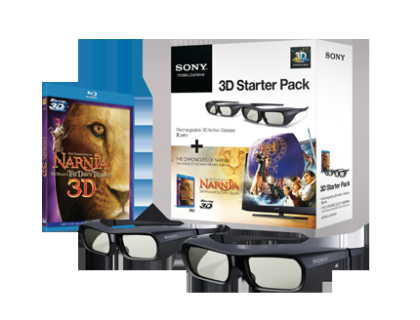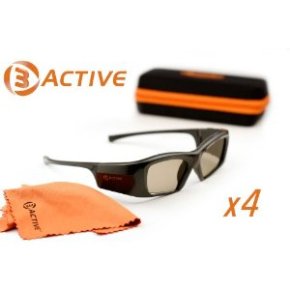So I have started to get into the 3D TV world. My first foray had me buying the Playstation brand 24″ 3D Display. Which, while awesome, left a bit to be desired still. 
For starters, the display was small, almost more like a computer screen than an actual TV. That being said, the 3D on the TV is awesome, it has the simulview technology that allows 2 players to view an entire screen rather than have to split the screen. This view is not available in 3D (it uses the 3D technology to display one image to player 1 and another image to player 2), BUT it is a very useful feature in that players now have the entire screen display their view of the action and not have to be distracted by the other player’s screen. I have yet to try this feature, but with my brother in town this week, we may get a chance to do that…
For approx. 2 to 3 years, this was the TV I used to watch my 3D movies on. I love watching 3D movies! Shortly after purchasing this TV, I also purchased the Sony 3D Starter Kit which included 2 pairs of the Sony model TDG-BR250/B 3D glasses (this is important later on in this blog) and a copy of The Chronicles of Narnia: Voyage of the Dawn Treader in Bluray 3D.
I figured the Sony 3D glasses would work on the Sony brand Playstation 3D display and I was not disappointed! The one difference with these glasses and the Playstion 3D display glasses is the lack of the simulview technology. In order for me to enable the use of Simulview on the Playstation 3D display, I would need to buy another pair of the Playstation brand 3D glasses (this is actually pretty viable due to some findings later on in this blog).
So far everything is all well and good. I had a 3D TV, I had 3 pairs of 3D glasses, just in case anyone wanted to watch 3D with me, although the 2 people that live with me (my wife and brother-in-law) can’t see 3D (my wife actually CAN see it, but it gives her a headache), and everything pertaining to 3D that I purchased worked well.
Now onto the ugly side of 3D. Right now 3D is undergoing growing pains, there is no universal standard yet and this is likely going to cause issues for everyone who purchased the original 3D tech as opposed to the current or future (hopefully standardized) 3D tech. For those that don’t know, there are 2 main types of 3D tech available right now.
One is the Passive 3D technology that uses polarized lenses in the 3D glasses to allow the viewer to see different images for each eye. This actually may be the best 3D technology based on several different factors: 1. the glasses are lightweight much like regular eyeglasses or shades, due to the fact that there are no electronics required in them. 2. Ghosting/Crosstalk is minimized due to the fact that the glasses don’t use the “shutter” technology. 3. 3D glasses for this technology is CHEAP, and I mean CHEAP, due to the fact that they are just glasses with polarized lenses.
The other type of 3D tech out there is called the Active Shutter 3D Technology. This technology uses LCD panels in the glasses that are “shuttered” into “on” and “off” states based on a signal it receives. The rates that the glasses shutter should be at the 60 Hz level. I believe the big positive in this technology is that it touts to be the best technology in terms of resolution. The Passive 3D glasses use interlacing to send the 3D image. That means that every other line on the TV sends the image specifically for one of the polarized lenses on the 3D glasses which then provides the 3D image. The active shutter glasses actually use the entire screen, but the image is only visible when the active shutter is in the “on” position so your eye really only sees the image specifically for that eye. There can be an argument made regarding loss of resolution with the passive 3D glasses in that the left eye and the right eye combined provide you with the total resolution that is equivalent to the method used with the active shutter glasses. There are a few minuses regarding the Active Shutter 3D technology, 1. The glasses are EXPENSIVE, this is because there are electronics contained in the glasses to create the “shutter” effect. 2. The refresh rate of the shutters (aprrox. 60 hz) can be noticed by some viewers or is just below the noticeable range, which affects the viewer by causing dizziness and nausea. 3. Ghosting/Crosstalk is more prevalent depending on the quality of the 3D glasses being used and the compatibility between the glasses and the TV it is linked to. Which brings me to my biggest complaint about the Active 3D technology. There are too many different manufacturers using different IR/Bluetooth specifications that it is a big HUGE pain to find the 3D glasses that will work with your 3D TV (more on this below).
The one downside I really see with the Passive 3D technology is that I can find cheaper 3D TVs that use Active Shutter 3D technology (which I did, more on that below). Passive 3D TVs are really only made with new LCDs/LEDs. The Active Shutter type 3D TVs are made in the DLP variety (for those of you that don’t know, DLP TVs are the step between the old BULKY Projection Screen TVs and the sleek and sexy new LED TVs.
That being said, I personally am a fan of the DLP TVs, yes they are fatter, yes they are older technology, yes the DLP bulb has a bad habit of burning out over time (approx. 5 years in my experience, but I have heard nightmare stories about bulbs going out in as little as 6 months). My favorite thing about DLP TVs is their cost… DLP TVs compared to LEDs or LCDs that are about the same size cost half as much. I can understand going with the LED TV route if you have limited space and want to hang your TV on the wall, but me personally, I have enough space to hold a fatter TV, and hanging my TV on the wall like a painting really isn’t a big deal to me. I have also heard that the viewing DLP TVs from different angles cause a significant drop in picture quality. I have attempted to test this using my existing DLP TVs, but I have not noticed this personally. But then again, I am one of those people that can’t tell the difference between 720p and 1080p…
Before I move on to my new 3D TV, you need to know a few things about me. 1. I have a limited budget. 2. I LOVE BIG TVs 3. I LOVE 3D! 4. I am kind of a geek (geeks think I’m stupid, non-geeks think I’m a geek, hence the kind of). Now that you know all that about me, let’s move on to my newly acquired 3D TV.
I went the DLP route with my new 3D TV for 2 main reasons. 1. Price 2. Size. That’s it. Period. I did little to no research prior to purchasing my TV other than my past knowledge that my 2 older DLP TVs have not given me any grief in the span of 7 and 4 years respectively. The 7 year old had to have it’s bulb replaced, but I found a cheap (less than $100) bulb to replace it, and that TV is now a backup TV since I have now replaced it with my new 3D TV. Oh and the cheap bulb I used did not in any way affect the picture quality of the TV. I should also say that I set my TV picture settings to improve the life of the bulb vs having the picture be super bright.
So the research I did do in order find my new TV is which place has the best priced 3D DLP TV on Black Friday. Turns out Frys had the best price, but you know Black Friday sales, quantities limited to stock on hand. Uh oh. So me in my great wisdom devised a plan which would ensure that I had a bigger 3D TV than my 24″ TV. I went to Sears and bought one of the Passive 3D TVs, just in case I wasn’t able to get my Fry’s 3D TV. The LCD was smaller, yes, but it was double the size of my 24″ TV so I wasn’t going to complain if that was the TV I was stuck with. I can’t tell you much about this TV since I never opened it. Yup, that’s right… Fry’s, my favorite electronics store in the entire world, HAD MY 3D DLP TV! Boo-yah! For only $100 more, I almost doubled the size of the LCD I just bought from Sears. Can you say “No Brainer”? I went back to Sears 2 days later to return the LCD TV and that was the end of my experience with Passive 3D TVs. Sorry LG, I did try to talk my wife into letting me keep both, but cooler heads prevailed and I opted for my movie theater sized TV over the “slightly smaller” LG.
The good, I have a huge 3D TV now, that I just love! The Bad. My DLP TV came with no glasses and my biggest complaint is that it does not have Audio outputs! What the F* kind of TV doesn’t have Audio outputs? Now this would not be a big deal had I a 3D HDMI surround sound system since all my peripherals would plug into the system and the system would just have the HDMI out to the TV, but I don’t have that! Son of a B*!
Addition to Erick’s want to buy list: 7.1 Surround Sound System WITH HDMI inputs.
OK, Deep Breaths, I love my new 3D TV, I love my new 3D TV, I love my new 3D TV…
Ingenuity kicks in. What am I going to use this 3D TV for? 1. HD Viewing with my UVerse Cable, my UVerse cable box has the A/V outputs so use the HDMI to get the HD viewing on the TV, but plug the A/V outputs to my receiver to get my Surround Sound Audio! I am so brilliant… Loving my 3D TV a little bit more now… 2. Playing my 3D movies and 3D video games on my PS3. The PS3 allows me to use the HDMI Cable for viewing and the PS3 A/V output for the audio! Brilliant! Now my PS3 is able to play my 3D movies and I can use the surround sound system with it too! 3. Playing my Xbox 360. The Xbox has the component video out. Boom! Attach the component video cable to the component video inputs of the TV and attach the audio portion to my surround sound.
OK, now I have my cable available with surround, I have my PS3 available with surround, and I have my Xbox available with surround.
I am a HAPPY CAMPER!!! BUT I still don’t have 3D glasses with the TV. Hmm, I DO have those Sony 3D glasses and the Playstation Display 3D glasses. Hmmm. Ok, let’s see if I put my 3D Bluray of the Avengers in, if I can get those glasses to work with the TV. Tested all 3 glasses. No go. Ok, I kind of expected that…The sales person at Fry’s said I would need to buy the emitter and 3D glasses separately. OK, I have the 3D glasses, but would these glasses that I have work with any 3D emitter? Some searching online really yielded no definitive answers. I have the definitive answer for the glasses that I own and the following 3d emitter purchased from amazon.com.
I don’t see any model numbers for this emitter on Amazon, but I do have it after purchase. It is the 3DGU-E2 Emitter.
This emitter does work with my Playstation 3D glasses, however, I do notice the flicker on the glasses and it does not work as well as the DLP Link glasses that I purchased. The DLP Link technology is built into the DLP TV so the emitter is not necessary with these glasses. I bought a four pack of the 3 active DLP Link 3D glasses for $200 bucks. This deal had each glass in a sturdy case, not the cloth cases that the sony glasses came in. Each one also came with it’s own charging USB Cable, like the sony glasses, and as an added bonus, I got 2 USB wall plugs so that I can charge 2 of the glasses at a time, I really didn’t need this as I am sort of a geek, I have tons of devices that I charge via USB and I bought the wall plugs for USB charging and will have 2 or 3 on hand that aren’t in use at a given time, but a perk’s a perk.
So to make it absolutely clear. the 3DGU-E2 High Power Emitter is compatible with the PS398079 Playstation 3D glasses. HOWEVER, the 3D glasses I purchased with the Sony 3D starter kit (TDG-BR250/B) DOES NOT WORK with the emitter. I have tried multiple different settings. I have tried Reverse on the TVs menu to reverse the IR signal being sent and that didn’t work, then I tried the Reverse on the tranmitter to see if that would work. None of the four configurations worked (normal transmitter/normal tv, normal transmitter/reverse tv, reverse tranmitter/normal tv, and reverse transmitter/reverse tv). So currently I have 3 glasses that will work on my Playstation 3D display (at the time of writing I actually bought a pair of the Playstation 3D glasses, so this is technically not a lie, I haven’t received the fourth pair yet), and I have 5 glasses that will work on my DLP TV (this will be bumped up to 6 when I receive the latest pair that I ordered).
There is now another option with Active Shutter glasses which is to use bluetooth technology for the synching of the signals. I haven’t even attempted a foray into this tech so all I can tell you about it is that it is out there and you have to be careful when you buy your 3D glasses to make sure that it is a pair that will work with your existing set up. Or if you are newly setting up, I would recommend that you buy kits, which gives you the glasses, an emitter, and sometimes even some 3D content to help you get started on your collection.
I can tell you definitively that I love my 3D setup, I have made mistakes in maybe jumping in too soon without giving it due diligence and researching what would work with what. But I did not want to spend a fortune on a 3D TV, when I could spend a little for a lot in terms of the DLP TV that I purchased. Hopefully soon the active shutter glasses get cheaper, but I will make do with what I currently have. After all, I now own 2 3D TVs and I still love both of them! Although, I have only owned the new DLP TV for only a week now. I will update this topic in about a year or so to make sure I still love it after owning it for a while.


